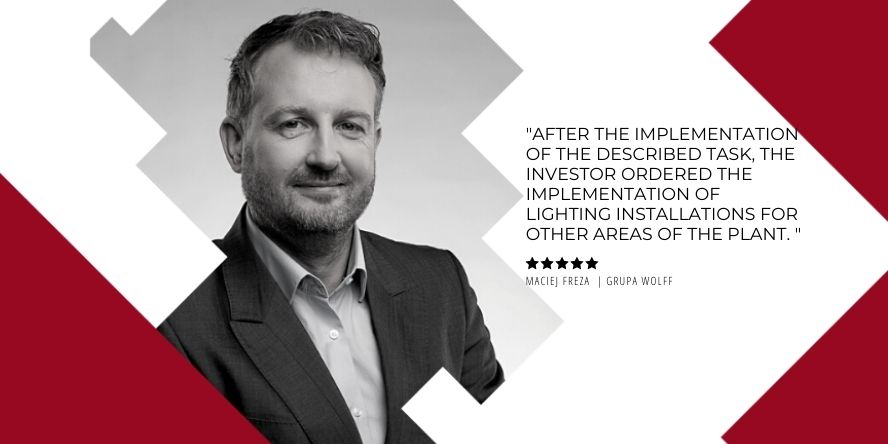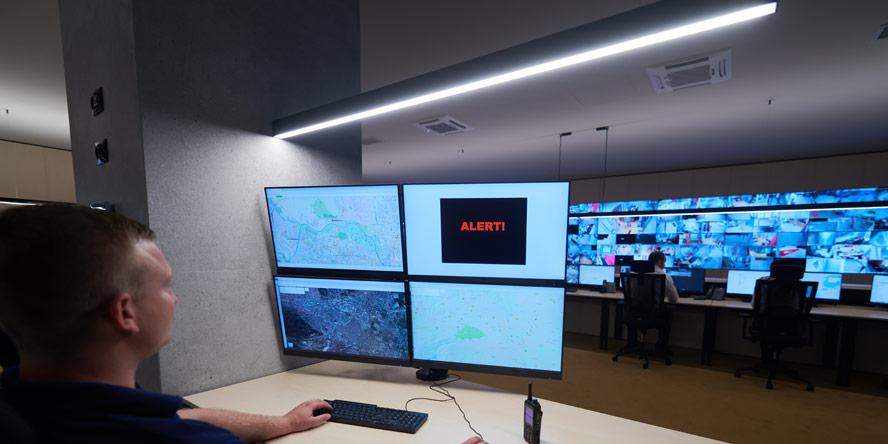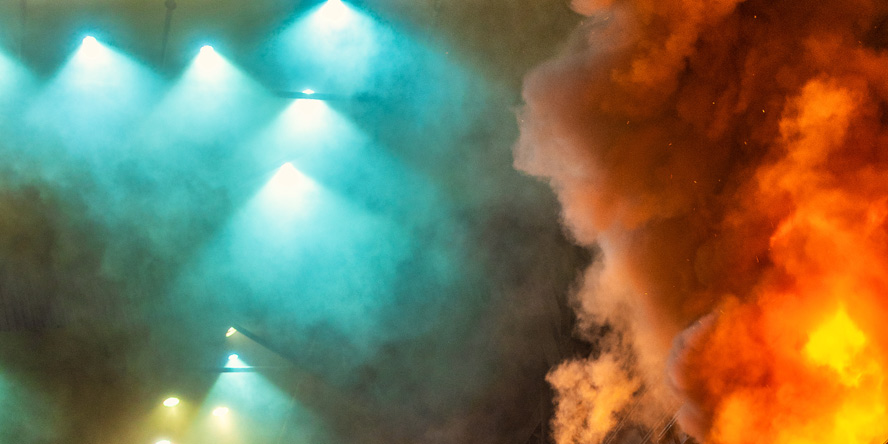Problem:
- the investor needed to provide emergency lighting for a large area located inside the hall and outdoors;
- the installation was required to guarantee light intensity levels several times higher than those required by the standards at individual locations;
- a typical installation based on fixtures with built-in batteries would be problematic and would require a higher number of fixtures
Remedy:
- we designed a project indicating i.e. the optimal source of emergency power supply, type, number and location of fixtures;
- we based the installation on a central battery, which solved the problem of cumbersome tests and short battery life;
- thanks to the central battery, we could also use fewer fixtures, while maintaining the required light intensity.
Special requirements of the investor
Investment too big for autotests
Dual-function fixtures

Emergency lighting with dual-function fixtures in a storage area – an exampl
The task set for the WOLFF GROUP engineers was to design and implement an emergency lighting system for a large warehouse and social area. The key to the investment execution were the requirements of the investor, who expected the installation to achieve light intensity several times higher than required by the standard at many individual locations. This had quite a few implications for the project implementation, as described below.
Emergency lighting must be provided with an independent power supply
According to regulations, emergency lighting must be provided with an independent light source. Two solutions are used in industrial practice:
- fixtures with integrated batteries,
- central batteries supplying all fixtures from a single location.
In both cases the energy source is a battery that must provide continuous, uninterrupted power to the fixture for at least 60 minutes.
Battery integrated in the fixture or central battery
The decision on how to provide the independent power supply for the emergency lighting fixtures is extremely important. A mistake made here can have significant consequences. For example, in the case described above, selection of emergency fixtures with an integrated battery would result in:
- monthly manual inspections of nearly 300 fixtures distributed over a large area,
- shorter battery lifetime caused by the influence of ambient temperature (battery lifetime is specified for 20oC – a deviation from this value results in a significantly shorter lifetime. For example, a temperature increase of 10oC decreases battery lifetime by half).
At this point it should be emphasized that during the implementation of the described project we met with an extremely aware investor, who oversaw several expansions of its industrial sites, and thus had to install basic and emergency lighting systems in new buildings. For this reason, already at the beginning we received information from the investor indicating that the project should be implemented using a central battery system, which will serve as a power source for emergency lighting fixtures. Nevertheless, it is worthwhile to discuss the basic advantages and disadvantages of each power source below.

The requirement to test emergency lighting fixtures and the power source for emergency lighting fixtures
According to EN 60598-2-22, emergency lighting fixtures must enable their testing without the need to turn off the power. Such tests shall be performed regularly:
- monthly, checking that the batteries are working properly,
- yearly, verifying that the fixture operates in emergency mode for the full time declared for it.
Emergency fixtures with an integrated battery
Almost nobody in the industry chooses to manually test fixtures any more, unless only one or several fixtures are tested. In the case of fixtures with an autonomous battery, a self-test in the form of green and red LEDs mounted in the fixtures is most commonly used. Correct operation of the fixture may be assessed visually then, and whether its battery has enough energy stored in order to meet the minimum requirements of its remaining lifetime.
Autotest is the economically optimal solution for a small number of fixtures. At higher numbers (dozens of fixtures and more), this form of testing can be cumbersome and time-consuming, and thus expensive. This is because it requires a visual inspection of each fixture, one at a time, each month and the test result to be recorded.
Emergency fixtures with a central testing system
A solid alternative includes a central fixture testing system with an independent battery. Each fixture then connects to the central testing station used to perform all tests. The central control system requires all emergency lighting fixtures to be interconnected using an additional cable, which carries the test signal to the central control unit. Thus, taking into account the fact that wiring should be routed between the fixtures only for the purpose of being able to control the test from a central station, the same wiring may as well be routed in order to provide power supply to all emergency lighting fixtures from a central battery. This is a solution that becomes far more cost-effective in the long run.
Fixtures with central battery and a testing system
The disadvantages of the above solutions are eliminated by the power supply provided from the central battery. By using it, it is possible to eliminate the problem with cumbersome and time-consuming tests. And by eliminating the effects of temperature on battery life, the useful lifetime of a battery may reach 10 years.
In the case of fixtures with integrated batteries, the situation is not as bright. Even at the very outset their lifespan is much shorter, as they last only 4 years. However, when ambient temperature deviates from the assumed value of 20oC, this time may be reduced even to half a year, as shown below.
Central battery is obviously not the ideal solution for every situation. For example, using it at sites with a maximum of several dozen fixtures makes no sense.

Influence of ambient temperature on battery lifetime
As Maciej Freza, head of the lighting department at the WOLFF GROUP, explains – the service life of the battery cell is halved each time the ambient temperature rises by 10°C over 20°C. This means that the battery will retain its rated parameters twice as long as the manufacturer declares. Meanwhile, operation of fixtures in temperatures of 40 or 50oC is not uncommon in industrial conditions.
To illustrate this problem, let us have a look at the cases presented in the following table.
[table “121” not found /]Table 1. Battery service life including rated parameters as a function of ambient temperature
Freza also points out the impact of negative temperatures – negative temperatures also have negative impact on the operation of an energy source such as a battery, reducing the amount of available energy from the battery. Due to the physico-chemical processes taking place, it is possible that energy stored in the battery cannot be fully used, and if the cells are in poor condition, this results in insufficient power being supplied to the power supply unit, making it impossible to start the emergency lighting.
Key question – how to take care of battery life?
Emergency fixtures with an integrated battery
As shown above, ambient temperature has major impact on battery life. In the case of fixtures with an integrated battery, we must therefore take into account the local temperatures, which can vary significantly, depending on the installation location of the fixture. Some of the key factors leading to local temperature differences at the site include:
- proximity of heat sources (equipment, engines, etc.),
- HVAC systems,
- installation height of the fixtures inside the hall (the higher, the warmer it is)
- the influence of the Sun (acting directly on fixtures installed outdoors or as sunlight falling into the object, e.g. through windows and skylights),
- different temperatures in different rooms, airflow obstructing partitions,
- installation of fixtures indoors or outdoors.
All these factors result in a shorter service life of batteries. Moreover, virtually any fixture may require the battery to be replaced at a different time. It is impossible to avoid these problems in most cases.
Emergency fixtures powered from a central battery
A much easier manageable battery life is ensured using a system powered by a central battery. All batteries, together with the control panel, are enclosed in a single cabinet. For this reason, temperature fluctuations around individual fixtures are irrelevant from the point of view of battery life.
Moreover, if it can be ensured that temperature inside the cabinet oscillates around 20oC, it is very likely that the service life of stationary batteries, which is rated at 10 years according to EUROBAT, can be maintained.

Emergency lighting in dual-purpose fixtures in a control room – an example
Special requirements of the investor
Let us return to the initial requirements of the investor: we were asked to propose a system of emergency lighting fixtures for a large warehouse and a social area. Although most of the fixtures were to be installed indoors, some had to be installed outdoors.
The extensive indoor and outdoor space does not allow control over the operating conditions and temperature affecting the service life of batteries integrated into the fixture. Moreover, the possible execution of auto-tests for nearly 300 fixtures would be very cumbersome and time-consuming.
Thus, if the investor had not declared the requirement of using the central battery system, we would have certainly made such a suggestion.
The need for dual-purpose fixtures
An additional, special requirement which had to be met, was an appropriate choice of emergency lighting fixtures, which had to provide light intensity significantly exceeding the minimum parameters required by law in many locations
- the investor classified the entire area of the investment as a “high risk zone”, and thus the emergency lighting had to provide at least 10% of the intensity of the basic lighting, but not less than 15 lux
the investor also designated many zones for which the above requirements were further raised. These included:
rooms where electrical switchboards are located – with a requirement of at least 30% intensity of the basic lighting - control rooms and other management rooms – with a requirement of at least 50% intensity of the basic lighting. Thus, the emergency lighting system had to provide 250 lux in this case. If the investor wanted to meet only the minimum requirements of the standard, this value would be “only” 50 lux.
Even if the investor considered the use of emergency fixtures with power supply provided by integrated batteries, the above requirements, already within the minimum intensity specified in the standard, are difficult to achieve with autonomous fixtures.
Fixtures dedicated exclusively to emergency lighting are smaller and provide lower light intensity than primary lighting fixtures. Thus, even with the intensity requirement of 20 lux, calculations often show that ordinary emergency fixtures would have to occupy most of the ceiling area, a solution which is not only uneconomical in terms of costs but also lacks aesthetic appeal.
In such situations dual-purpose fixtures become the solution of choice. These are fixtures that can be supplied with two independent power sources – primary and emergency source. These fixtures can then operate as the basic lighting system and in the case of power failure they switch to the secondary source – the emergency power supply.
In the case of the discussed project, a large proportion of the dual-function fixtures we used performs exactly such a double function. We also installed dual-function fixtures in places where basic lighting was already present, but the dual-function fixtures were the only economic form providing the adequate light intensity for the investor, although they were used only as emergency lighting fixtures in this case.
After the implementation of the described task above, the investor ordered implementation of lighting installations for other areas of the site.






